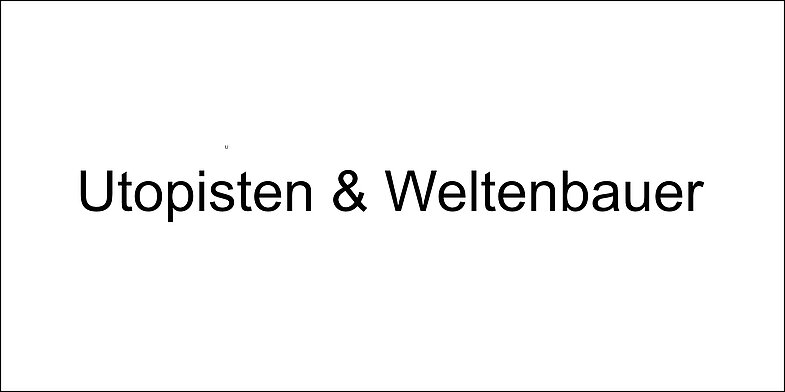
Do we still aspire to utopian dreams? Can utopian visions - in the sense of Thomas More’s novel “Utopia”, written nearly 600 years ago, in which he described a fictional “ideal” society and constitutional order – still be found in contemporary art? Or do artists today prefer to construct terrifying dystopian worlds?
This exhibition contains artworks in various media, such as film, drawing, installation and participatory projects, which invite viewers to explore fictitious forms of being. They lead us through urban and architectonic worlds, reviving fantastical literature and proposing sociological and political states of human co-existence, which although imaginable are perhaps not yet feasible.


Two screens, set opposite one another, show a filmic collage of historic film footage. Standing, mesmerised in between a combative Martin Luther King jr delivering his “I have a Dream” speech of 1963, and Barrack Obama’s “Yes we can” optimism of 2008, the visitor is witness to a fictitious encounter between two icons of American politics. The slogan-like redundancy of each expression, as well as our knowledge of how history played out, generates unease and considerable doubt about these once optimistically proclaimed statements. We remember the fights, traps and victims, which are part of the timeline that linked these two historical moments and consider whether we are still attempt to realise these utopian visions.
http://biloshytskyy.com

It is as if we had a second planet to which we could move …
Everywhere we look, repair-cafés have appeared as an answer to the disposability inherent in consumer society, to the excess of dismissive and fast procession of materials. In a low- or post-growth economy, a new interaction with the world is proposed through DIY, growing food yourself, servicing & repairing, solidarity and renouncing excessive consumerism. Low- or post-growth economy questions our reliance on economic growth as a route to abundance.
Susanne Bosch regards the furniture garbage on the inner city streets as ideal material pool in order to build in collaboration withlocal residents new usable objects from it. On site, the MOBILE WORKSHOP will in function. During the exhibition, the MOBILE WORKSHOP will build book boxes out of the found furniture in the Dortmunder North city.
The purchase of the MOBILE WORKSHOP is financed by the ‘Chances', the new currency on the Borsigplatz. After the exhibition, the workshop is permanently based in the Borsigviertel.
www.susannebosch.de
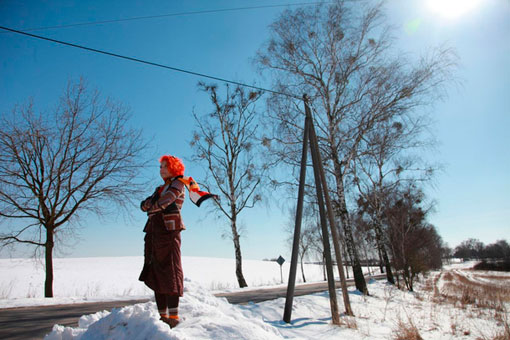
barbara caveng's artistic work ranges from sculpture to installation with a focus on participatory art projects.Equipped with the project grant Kunst fürs Dorf – Dörfer für Kunst the artist moved from April to October 2013 to a village on the Polish border. Feeling herself to be a stranger she explored the geographical space and the social structures of the village of Blankensee. The life stories of the elderly, long established local inhabitants revive flight, expulsion and exile. Recent immigrants try to adjust to life in a rural setting. The desire to arrive , the wish to remain and the need for existential security accompany the longing for belonging and social cohesion of all residents – essential human needs equally in rural and urban areas.
The installation MI KRICHT HIER KEENER MEHR WECH | HEIMISCH (nobody's gonna get me outta here | having a sense of feeling at home) at Künstlerhaus Dortmund brings the small wide world of a village to life, describing exemplary identity issues, burst dreams and growing hopes.
www.kunstgemeinde-pampsee.net
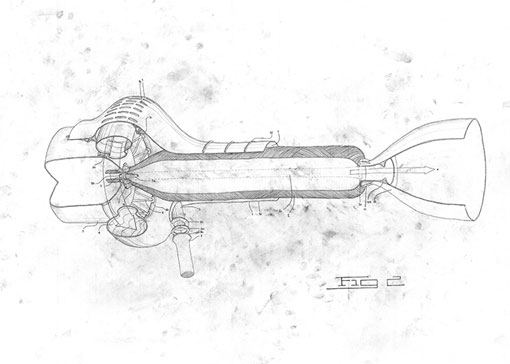
The X-Prize was a competition organized by the American X-Prize Foundation until 1996, which awarded a prize to whoever achieved the first private manned space flight. On September 29, 2004, SpaceShipOne, which belonged to the firm Scaled Composites, reached the required altitude of 100 km, beating thirteen other competitors to the ten-million-dollar prize. At the start of the 21st century, the large government financed space-travel firms are in a state of crisis. From 2010, the American space agency NASA withdrew its outdated space shuttles from service, even though the follow-up replacement Orion won't actually be ready until 2014 at the earliest, and the European space agency ESA continues to postpone one mission after another. Private enterprises are now seemingly vying with one another to fill this gap. The situation is comparable with the enthusiasm and optimism surrounding space travel in the 1950s and 1960s—with the difference now being that it is all about private-sector interests, not national prestige and military research on behalf of superpowers engaged in a Cold War. Stefan Eichhorn's work Operation Paperclip addresses these events.
In addition to an object, a fragment of a spacecraft somewhere between completion and destruction, three technical sketches and drawings will be shown in the exhibition. On close inspection of Eichhorn’s work, it quickly becomes apparent that we are dealing with a mock-up: the construction remains an empty shell, and the supposed inventions prove to be pure fantasy. The dream of flying ultimately remains a dream in this instance.
http://stefaneichhorn.de
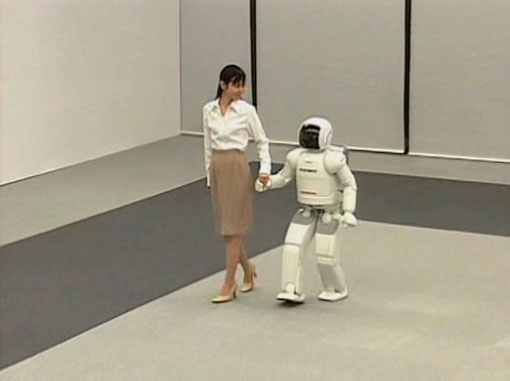
Since the mid-1980s HONDA has been working on the development of humanoid robots for use within the human environment. ASIMO, one of the most advanced humanoids, will in the future be able to carry out such tasks as, for example, looking after the elderly. His counterpart OMIZA places himself on the other side of the mirror. In the company of a woman he learns of a well-ordered world which exists only for him and for their endless walks through the labyrinths of heart.
„The material gathered from research films features the humanoid robot ASIMO. He is already capable of complex human manoeuvres and social behaviour: he goes hand in hand with a young woman for a walk, waiting for her if she lags behind, or steers a trolley correctly within pre-determined pathways. In Le Nouveau OMIZA the first attempts to reconcile human and non-human beings are charted, and a new form of communication is tested. The coming-together of woman and robot is also reflected through the use of sound: Erik Satie’s piano piece Gymnopédie No. 1 is interpreted both by a pianist and by a piece of composition software.“ (Angelika Richter)
www.h--a.org
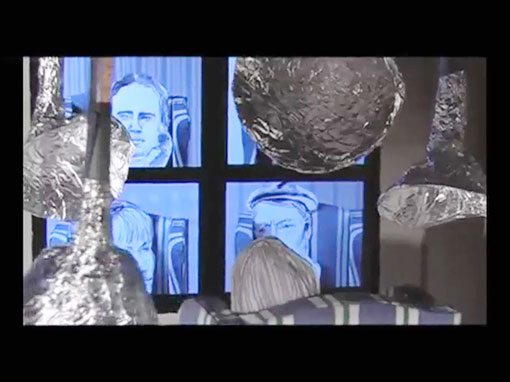
The surface of the earth has become uninhabitable and mankind has created a new über-machine which allows them to live underground in a new artificial world of mediated communication via screens and speech tubes. To have ideas is the ultimate goal. Then something goes wrong. Written in 1909, E.M. Forster’s The Machine Stops is a dystopian story that is frighteningly relevant 100 years later.
Written in 1909, E.M. Forster’s The Machine Stops is a dystopian story that is frighteningly relevant 100 years later.
www.christine-niehoff.net

In the 90s the cuties – small grey cartoon characters by Felix Reidenbach – regularly populated the music magazine Spex. Since 2009 the poetic and satirical multimedia art comic series has had its own web publication. Now the friendly looking little guys are guests in the exhibition “Utopians and Creators of Worlds”. One of them is shown, looking rather innocently, on a small plastic card: The MeatCard. Allegedly issued by the Federal Ministry of Food, Agriculture and Consumer Protection in Berlin advertised with the slogan “125gram per week – a reasonable serving”. With their MeatCard the cuties take us along to a parallel world of our media and political landscape.
In the world of the cuties the heated debate about meat consumerism with its impact on climate change takes place by all available means and in all media. In the big talk shows of the fictitious media world the pros and cons of the MeatCard are discussed. Offshore meat flight, black market meat and illegal butchering are arguments of the MeatCard opponents. Whole industrial branches object to the MeatCard. The meat credit on the card can be topped up. It comes with guaranteed data protection. For sceptics and meat addicts there are indeed alternatives: a vegetarian diet or the anti-meat-eater-patch as abstinence assistance. The latter provides its cute bearer for 72 hours with a balanced meat dose.
Is all this only fiction, a utopian dream, a scary dystopia or after all a sustainable vision for the future? How was that again with the suggestion of the Green Party for a Vegie Day…?
www.dieniedlichen.de
… The wall installation Bon Voyage is a well-arranged assemblage of lined and yellowed file cards on which each has been placed a postage stamp. What unites the cards is their identical design, it is only the stamp that differs from card to card. Each stamp – that most popular of folk icons – deals with the notion of flying, no matter what country it originates from. All the stamps show an aircraft: beginning with airships and early Montgolfièrs right up to propeller-planes and fantastic hot-air balloons. It is a journey around the world – not in 80 days, but rather in 80 stamps.
On the ground in front of the installation there is a stack of different cards, which, operating like a plinth, hold a temptingly haptic flying device. A propeller construction made from two transparent orange plastic spoons – which may have escaped one burning hot summer day from their iced-coffee glasses – sticks in a golden something. This alienated cleaning utensil becomes a technically charged-up high performance battery and – with its shimmering structure – literally resorbs the surrounding light, gearing up to take off.
From: Aircraft’s Innocence, Trust and Longing in the Works of Gaby Taplick, Stephan Weitzel
www.gabytaplick.com
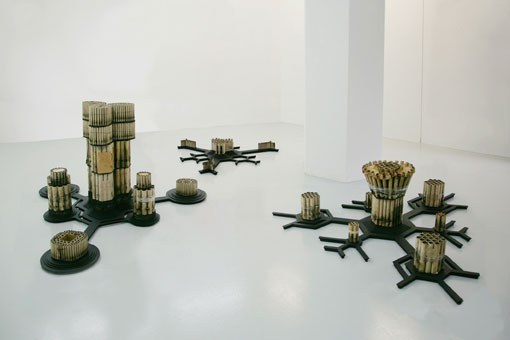
Isolated Space Structure is a manifestation of formal memories. Originated from a multitude of urban impressions, the installation deals with the phenomenon of rapidly built architectural mega-projects. These often act as a reminder of ancient cultural buildings, whose extent neither withstand the temporal nor the spiritual value of old cultural sites. Features of buildings, which once were religious motifs, today are adapted by mega-projects whose higher purpose only serves the market. The installation addresses the solitary position of these building projects and creates a network of architectonic elements constructed from burnt-out fireworks, and alludes to ruins of huge buildings. In contrast to the spent fireworks, which represent urban destruction, are the horizontally aligned socket elements, which appear as a growing structure. In spite of their being close to the ground they seem to hover like islands, detached from the Earth beneath them. From an aerial perspective, an abstract structure presents itself to the observer, generating associations with urban, as well as natural, contexts.
www.katinkatheis.de
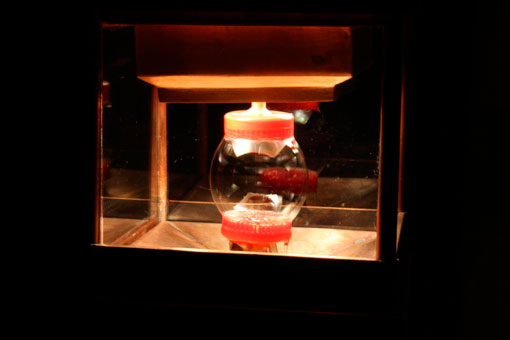
A chosen bubble can be place on the rim-holder in the center of the machine. It is now maintained by a constant flow of soapbubble-solution which prevents the bubble from dehydration and bursting. A soapbubble conserved this way can be kept for at least 10 hours.
www.janvormann.com